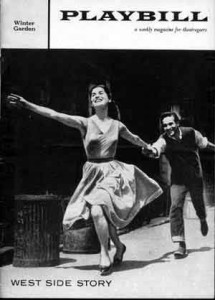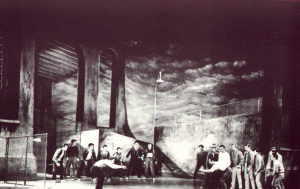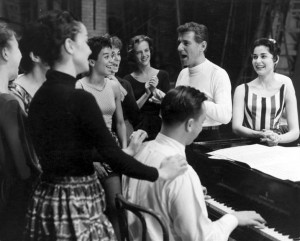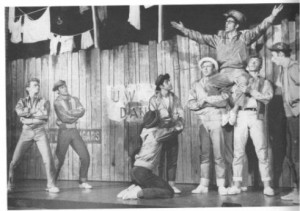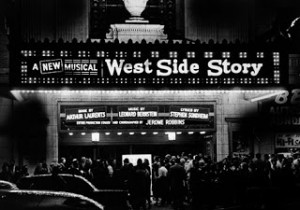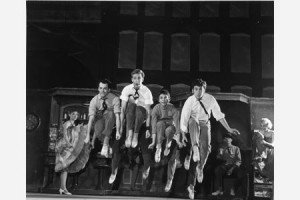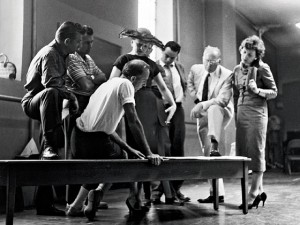
The West Side Story (1957) creators, including from left , Bernstein, Laurents, Robbins, and Sondheim,
West Side Story brought together the creative talents of some of the finest artistic minds on Broadway, including Jerome Robbins, Leonard Bernstein, Arthur Laurents and Stephen Sondheim. It would be a reimagining of the American book musical featuring a contemporary American story and setting, a dynamic orchestral score, insightful, multilayered lyrics and choreography that would redefine and reinvigorate musical theatre. But West Side Story was a musical that was slow in getting off the ground as it ran into various roadblocks, including creative/artistic concerns, a lack of investors and general doubts concerning its viability.
The First Five Years
In 1947, Robbins, Laurents and Bernstein began collaborating on a musical based on Romeo and Juliet. Set in modern day Manhattan, the project was called East Side Story and it focused on a Jewish girl who had survived Nazi Germany and emigrated from Israel, an Irish-Catholic boy who was born in the U.S. and their forbidden love. The opposing gangs were the Jets (Catholics) and the Emeralds (Jews). The musical, which was set during Easter and Passover, was to explore anti-Semitism
Robbins and Laurents saw it as a lyrical theatre piece while Bernstein pushed for an operatic score. This was Laurents first chance to write the book for a Broadway musical and he got to work quickly. When the three read Laurents’ draft of the libretto, they realized that they were rehashing themes that had been overdone on Broadway and they abandoned the project and went onto other things.
Putting It Together
In 1955, the project resurfaced. Laurents and Bernstein were both in Hollywood working on different projects when they met. Gang violence and warfare had become headline news in the U.S. In California, Chicano gangs were clashing and while Laurents and Bernstein were discussing the phenomenon, they realized that the topic might be right for East Side Story. Laurents, who was much more familiar with New York, suggested that they focus on Puerto Rican and White youth and set the musical in the West Side of Manhattan. They contacted Robbins, who was now onboard with the reimaged East Side Story.
Bernstein felt that the score would be overwhelming and desired a lyricist. Laurents, who knew Sondheim professionally, contacted him to see if he’d like to write the lyrics. At first, Sondheim was resistant to the idea as he wanted to compose musical and not simply writer lyrics. But his close friend Oscar Hammerstein II convinced him that the project was a great opportunity and Sondheim joined the team.
Groundbreaking Show
By 1956, the book, music and lyrics had been created. But producers were not interested in a musical that they felt was much too dark and depressing. Cheryl Crawford had agreed to take on the project but when it became impossible to raise the needed funds, she left the show. With no backing and no one interested in raising money for the musical, West Side Story appeared to be doomed. The Sondheim contacted his friend Hal Prince.
Producer Hal Prince remembers West Side Story.
West Side Story might have never been done if it weren’t for theatre producer Hal Prince. Prince, who was at the start of what would be a magnificent career as a Broadway producer and director, read Laurents’ book and was interested in the new musical but unsure about it. Prince was then in Boston producing George Abbott’s New Girl in Town, which was in trouble. Abbott had mentored Prince and was a close confidant, so the young producer asked Abbott’s opinion of West Side Story. Abbott told him to turn it down, but Prince doubted his mentor’s advice. He contacted his business partner Robert Griffith and the two flew to New York to hear the score. Bernstein and Sondheim played and sang the musical numbers for the two men and with that West Side Story had found its producers.
Conflicts Abound
The development of any Broadway musical is an arduous task that’s rife with innumerable problems, including money issues, conflicting egos and developmental snags. In this way, West Side Story was no different than any other musical. There were concerns about Bernstein’s music being too complex and difficult to sing, Sondheim’s lyrics too educated and clever for audiences and Laurents’ book too depressing for a musical. At first, Robbins decided he only wanted to direct the show, leaving the choreography to someone else. He was concerned that the typical four-week choreography rehearsal schedule was too short. Prince said he would extend it to eight weeks and Robbins agreed to both direct and choreograph.
West Side Story- the Hit
Larry Kert and Carol Lawrence on The Ed Sullivan Show
When West Side Story was first seen on the road in Washington, D.C. and then Philadelphia reviewers and audiences were enthusiastic. The show opened on Broadway at the Winter Garden Theatre on September 26, 1957 and it garnered positive reviews.
The musical starred Larry Kert as Tony, Carol Lawrence as Maria, Chita Rivera as Anita and David Winters as Baby John. Although nominated for the Tony as Best Musical, West Side Story did not won that award (Meredith Wilson’s The Music Man received that award). It did receive two Tonys as Jerome Robbins won for Best Choreography and Oliver Smith for Best Scenic Design. Other nominees included Carol Lawrence (Best Actress in a Musical Supporting Role, Irene Sharaff (Best Costume Design) and Max Goberman (Best Musical Director and Conductor). The show ran for 732 performances, went on tour and then came back to the Winter Garden in 1960 for an additional 253 performances.
Legacy
The 1961 film of West Side Story was nominated for 11 Oscars. It won 10, including Best Picture, and it is still the only movie musical to win that many Academy Awards. Jerome Robbins and Robert Wise directed and won the Oscar in that category.
West Side Story is considered to be one of the greatest book musicals of all time. Laurents, who created a youth/gang language all on his own, wrote a book that masterfully uses elements of Shakespeare’s Romeo and Juliet and just as masterfully eschews other aspects. Bernstein’s score soars, evoking emotions in audiences through its dynamics while illuminating character, heightening emotion and developing the dramatic action. Sondheim’s lyrics reveal a fast range of emotions and are at various times gritty, clever, romantic, angry and much more. These three elements alone make West Side Story a brilliant American book musical. With Robbins’ choreography and direction, West Side Story became a great piece of theatre that utilized ballet-based dance and various other styles in equal measure with the other three elements, allowing it to define character, conflict and the progression of the story.
Interestingly, although West Side Story can be said to be a highly stylized piece of musical theatre, it is also simultaneously extremely real. Somehow the four major creative talents responsible for its inception managed to find the balance between stylized and realistic performing. American musical theatre reached a new height with West Side Story.

